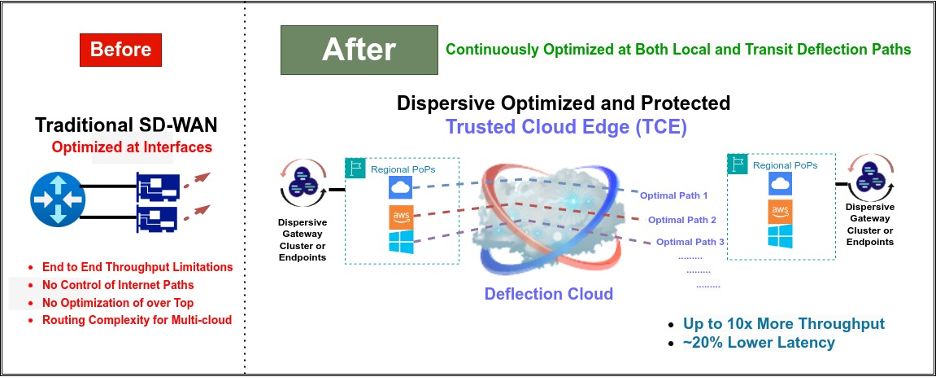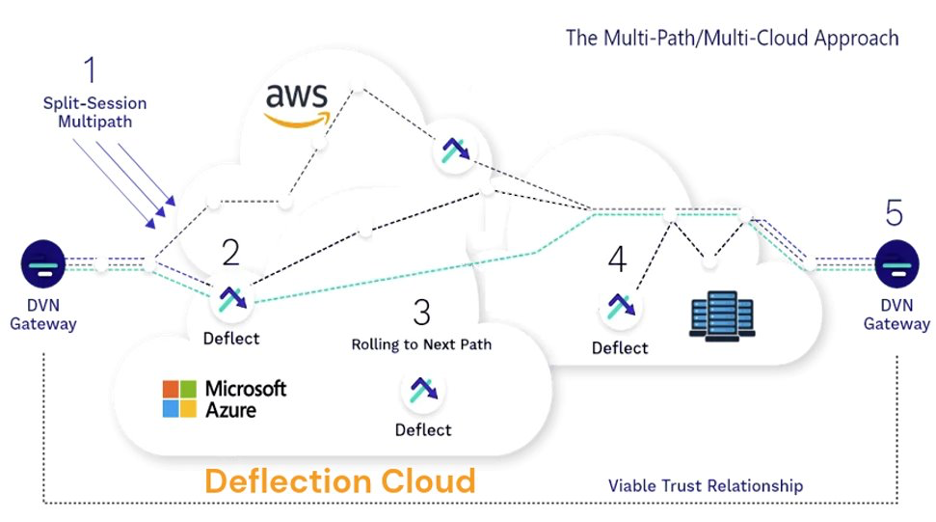We live in a world obsessed with speed and reliability. Whether it's streaming our favorite shows, conducting mission-critical business operations, or simply browsing the web, we demand seamless connectivity. This has led to the rise of many SD-WAN and router providers touting multipath solutions – the promise of using multiple network paths simultaneously to boost performance and ensure resilience.
Not all multipath is equal, or even located in the same places
But let's be honest, not all multipaths are created equal. You might think you're leveraging the full potential of your network with traditional gateway-level load balancing, and while that's a good starting point, it's only scratching the surface.
To truly unlock the power of multipath, you need something more, something revolutionary: the Deflection Cloud from Dispersive. Figure 1 below depicts the benefits of applying multipath using the Dispersive deflection cloud at various pop locations vs the traditional SD-WAN VPN point to point approach. Optimizing traffic in the middle has a more dramatic effect on typical performance due to ISP oversubscription at peering points.
Figure 1. Multipath at both local gateways and the Trusted Cloud Edge (TCE) with Dispersive

Think of traditional gateway load balancing as having multiple lanes on a highway, but all the traffic decisions are made at the on-ramp. The gateway decides which lane each car takes based on pre-defined rules or simple metrics. While this can distribute traffic and offer some redundancy, it's inherently limited. You need a capability of Distributing traffic in the middle of the internet (at intersections that are optimized).
Why gateway-level load balancing alone falls short:
- Limited Real-time Adaptability: Gateways typically make routing decisions based on static configurations or coarse-grained, aggregated metrics. They lack granular, real-time visibility into individual path conditions like latency, jitter, and packet loss of paths outside their “normal” routes. If one lane on our highway suddenly becomes congested further down the road, the cars already in that lane are stuck, and the gateway might continue to direct new traffic into the bottleneck.
- Inability to React to Transient Issues: Network conditions are dynamic. Microbursts of congestion, temporary link degradation, or even localized interference can significantly impact application performance. Gateway-level load balancing often reacts too slowly, if at all, to these fleeting issues, leading to dropped packets and application slowdowns. They are also inherently unable to affect the traffic in their core network transport layers, outside typical routing concepts or single-hop gateway interface optimizations which aren’t effective at a more abstract core network transit level.
- Lack of True Path Diversity at the Packet Level: Gateway load balancing usually operates at the flow or packet level (e.g., based on source/destination IP and port) and is limited to its own localized traffic control domain. This means all packets belonging to a single application flow are still typically confined to a single underlying path. If that path experiences problems, the entire application suffers. There's no ability to dynamically shift individual packets across different paths in the backend transit areas to optimize for real-time conditions beyond the reach of the gateway – e.g. you are still beholden to your ISP.
- Limited Security Agility: In a world of evolving cyber threats, the ability to dynamically shift traffic across diverse and geographically dispersed paths adds a significant layer of security. Gateway-level load balancing offers limited capabilities in this regard.
Enter the Dispersive difference: multipath with the Deflection Cloud
Dispersive Stealth Networking takes multipath to an entirely new dimension with our innovative Deflection Cloud. Imagine our highway analogy again, but this time, instead of static on-ramp decisions, you have a dynamic, intelligent air traffic control system constantly monitoring the conditions of every lane, every inch of the road. This is the essence of the Deflection Cloud (Figure 1 below).
Figure 2. Deflection Cloud – Deflects that relay traffic and obfuscate parties

Here's how Dispersive's multipath with the Deflection Cloud surpasses simple gateway-level load balancing:
- Granular, Real-time Packet-Level Intelligence: The Deflection Cloud continuously monitors the performance characteristics of multiple diverse network paths – wired, wireless, cellular, even satellite – at a per-packet level. It measures latency, jitter, packet loss, and other critical metrics in real time, providing an unprecedented level of insight into network conditions.
- Dynamic, Intelligent Packet Steering: Based on this real-time intelligence, the Deflection Cloud dynamically steers individual packets across the optimal available paths. If one path experiences congestion or degradation, only the affected packets are instantly rerouted to healthier paths, ensuring application performance remains consistent and uninterrupted. This is like our air traffic control system instantly rerouting individual cars around any emerging traffic jams.
- Unmatched Resilience and Reliability: By actively utilizing multiple paths and intelligently shifting traffic away from problematic links in milliseconds, Dispersive's solution offers unparalleled resilience. Even if one or more underlying network connections experience outages, the application remains operational, seamlessly leveraging the remaining healthy paths.
- Enhanced Performance and Lower Latency: By always choosing the best performing path for each packet, Dispersive significantly reduces latency and improves application throughput. This is especially critical for real-time applications like video conferencing, VoIP, and interactive gaming.
- Superior Security Posture: The Deflection Cloud inherently enhances security by distributing traffic across multiple disparate paths, making it significantly harder for attackers to intercept or disrupt communications. Furthermore, Dispersive's technology can incorporate sophisticated security policies and dynamically shift traffic to avoid potential threats.
Download: Secure Your Edge: The Future of CloudWAN Security White Paper
The proof is in the performance
Dispersive's multipath with the Deflection Cloud isn't just a theoretical improvement; it delivers tangible benefits in real-world deployments. Customers experience:
- Increased application availability and uptime.
- Improved application performance and responsiveness.
- Reduced latency and jitter for real-time applications.
- Enhanced security and resilience against network disruptions.
- Greater flexibility and agility in leveraging diverse network infrastructure.
Don't settle for basic multipath. Gateway-level load balancing is a step in the right direction, but it lacks the intelligence and granularity to truly unlock the potential of your network. If you're serious about achieving seamless connectivity, superior performance, and unwavering reliability, you need the Deflection Cloud from Dispersive.
Your multipath isn't my multipath without it. It's time to experience the difference Learn more about Dispersive and the power of the Deflection Cloud today! Please reach out to schedule a private consultation to learn more.
Additional Reading
Explore more blogs by Lawrence Pingree.
=> Your Network Is Showing - Time to Go Stealth
=> Secure AI Workspaces Need More Than a VPN
=> When Good Tools Go Bad: Dual-Use in Cybersecurity
Header image courtesy of rhythms on Freeimages.com.
Related Articles

Dispersive Achieves SOC 2 Type 2 Certification
In an era where cybersecurity threats continue to evolve at an alarming pace, Dispersive is proud...


